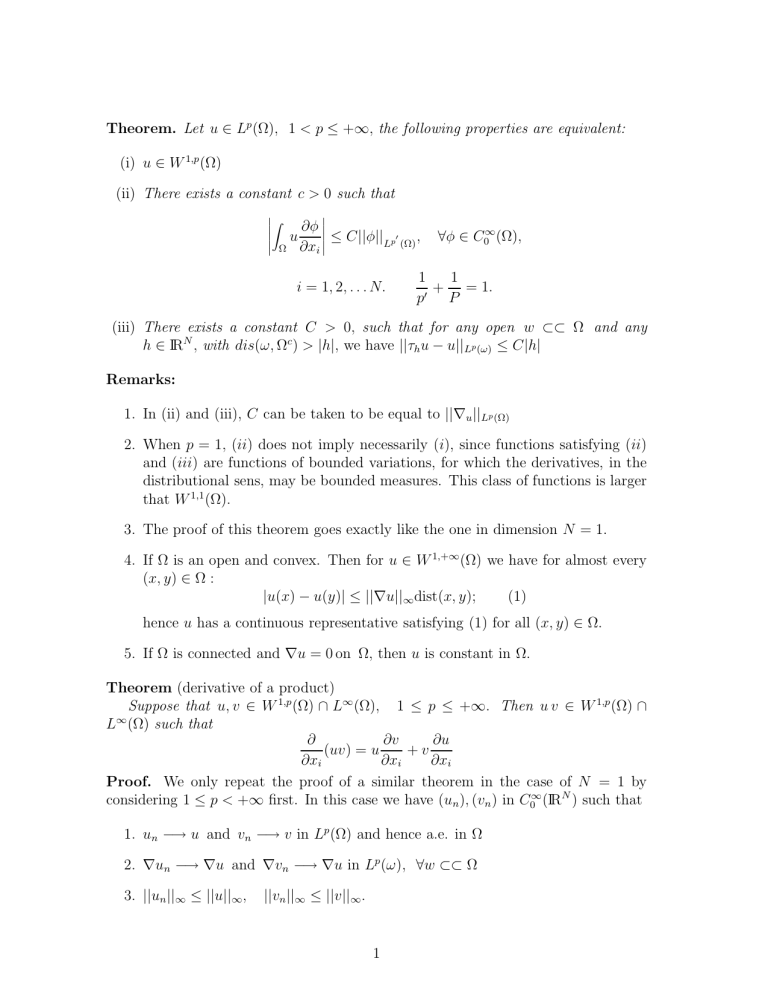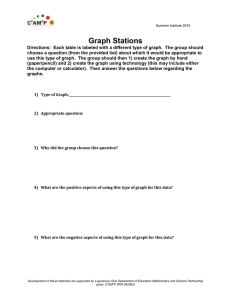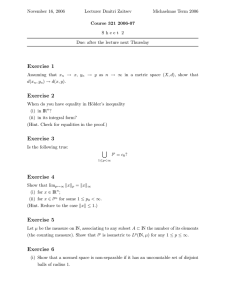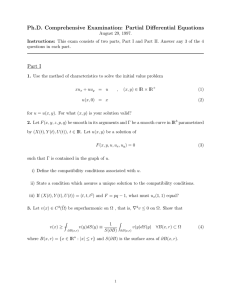Theorem. Let u ∈ L p(Ω), 1 < p ≤ +∞, the following properties are
advertisement

Theorem. Let u ∈ Lp (Ω), 1 < p ≤ +∞, the following properties are equivalent:
(i) u ∈ W 1,p (Ω)
(ii) There exists a constant c > 0 such that
Z
u
Ω
∂φ
≤ C||φ||Lp0 (Ω) ,
∂xi
i = 1, 2, . . . N.
∀φ ∈ C0∞ (Ω),
1
1
+ = 1.
0
p
P
(iii) There exists a constant C > 0, such that for any open w ⊂⊂ Ω and any
h ∈ IRN , with dis(ω, Ωc) > |h|, we have ||τh u − u||Lp (ω) ≤ C|h|
Remarks:
1. In (ii) and (iii), C can be taken to be equal to ||∇u ||Lp (Ω)
2. When p = 1, (ii) does not imply necessarily (i), since functions satisfying (ii)
and (iii) are functions of bounded variations, for which the derivatives, in the
distributional sens, may be bounded measures. This class of functions is larger
that W 1,1 (Ω).
3. The proof of this theorem goes exactly like the one in dimension N = 1.
4. If Ω is an open and convex. Then for u ∈ W 1,+∞ (Ω) we have for almost every
(x, y) ∈ Ω :
(1)
|u(x) − u(y)| ≤ ||∇u||∞dist(x, y);
hence u has a continuous representative satisfying (1) for all (x, y) ∈ Ω.
5. If Ω is connected and ∇u = 0 on Ω, then u is constant in Ω.
Theorem (derivative of a product)
Suppose that u, v ∈ W 1,p (Ω) ∩ L∞ (Ω), 1 ≤ p ≤ +∞. Then u v ∈ W 1,p (Ω) ∩
L∞ (Ω) such that
∂
∂v
∂u
(uv) = u
+v
∂xi
∂xi
∂xi
Proof. We only repeat the proof of a similar theorem in the case of N = 1 by
considering 1 ≤ p < +∞ first. In this case we have (un ), (vn ) in C0∞ (IRN ) such that
1. un −→ u and vn −→ v in Lp (Ω) and hence a.e. in Ω
2. ∇un −→ ∇u and ∇vn −→ ∇u in Lp (ω), ∀w ⊂⊂ Ω
3. ||un ||∞ ≤ ||u||∞,
||vn ||∞ ≤ ||v||∞.
1
So
Z
!
Z
∂φ
∂vn
∂un
un vn
=−
un
+ vn
φ,
∂xi
∂xi
∂xi
Ω
Ω
∀φ ∈ C0∞ (Ω),
∀i = 1, 2, . . . , N.
By letting n −→ ∞ and noting that supp φ ⊂⊂ Ω we easily see that
Z
∂φ
un vn
=−
∂xi
Ω
!
Z
Ω
∂v
∂u
u
+v
φ,
∂xi
∂xi
∀φ ∈ C0∞ (Ω),
∀i = 1, 2, . . . , N.
hence uv ∈ W 1,p (Ω) ∩ L∞ (Ω).
For p = +∞, u, v ∈ W 1,p (ω), ∀p < ∞, w ⊂⊂ Ω and hence we repeat the same
calculations.
Remark. It is necessary that u and v are in L∞ (Ω). So that u v ∈ L∞ (Ω), since u, v
in W 1,p (Ω) are not necesarily bounded in higher dimension spaces.
Example. Let
x
, (x, y, z) 6= (0, 0, 0)
2
2
2
u = (x, y, z) = (x + y + z )
0
, (x, y, z) = (0, 0, 0)
y
, (x, y, z) 6= (0, 0, 0)
x2 + y 2 + z 2
v=
0
, (x, y, z) = (0, 0, 0)
One can easily verify that u, v ∈ W 1,1 (Ω), where Ω = {(u, y, z) / x2 + y 2 + z 2 < 1} .
However
xy
, (x, y, z) 6= (0, 0, 0)
2
(x + y 2 + z 2 )2
uv =
0
, (x, y, z) = (0, 0, 0)
is not in L∞ (Ω). In fact uv ∈
/ W 1,1 (Ω).
Theorem. (Derivative of a composition)
Suppose that G ∈ C 1 (IR) such that G(0) = 0 and |G0 (s)| ≤ M
u ∈ W 1,p (Ω), then Gou ∈ W 1,p (Ω) with
∂u
∂
(Gou) = (G0 ou)
,
∂xi
∂xi
1 ≤ i ≤ N,
∀ s ∈ IR. Let
(ii)
Proof. Since |G0 (s)| ≤ M and G(0) = 0, ∀ s ∈ IR, then |Gou| ≤ M|u|. this implies
that Gou ∈ Lp (Ω). and
(G0 ou)
∂u
∂u
≤M
,
∂xi
∂xi
1≤i≤N
∂u
∈ Lp (Ω), ∀ i = 1, 2, . . . , N.
with (G0 ou) ∂x
i
To verify (ii) in the weak sense, we first take 1 ≤ p < ∞. So we know that there
exists a sequence (un ) in C0∞ (IRN ) such that un −→ u in Lp (Ω) and ∇un −→ ∇u in
Lp (ω), ∀w ⊂⊂ Ω. So for φ ∈ C01 (Ω) we have
Z
Ω
(Goun )
Z
∂φ
∂un
= − (G0 oun )φ
,
∂xi
∂xi
Ω
2
∀ i = 1, 2, . . . , N.
By taking n to ∞ and using the Dominated Convergence Theorem, we obtain
Z
(Gou)
Ω
Z
∂φ
∂u
= − (G0 ou)
φ,
∂xi
∂xi
Ω
∀ i = 1, 2, . . . , N.
Thus we have Gou ∈ W 1,p (Ω) and (ii) holds.
For p = +∞, we use the fact that v ∈ L∞ (Ω) then v ∈ Lp (Ω0 ), ∀p < ∞, ∀Ω0 ⊂⊂
Ω. We then repeat the above ”usual” analysis.
Remark. If Ω is bounded then G(0) = 0 is not necessary. Also if p = +∞, we
repeat the same analysis for Ω0 = Ω.
1
The Space W m,p(Ω)
Notation: Let α = (α1 , . . . , αN ) with αi ∈ IN, ∀i = 1, 2, . . . N, be a multi-index. We
denote by
∂ |α| u
, where |α| = α1 + . . . + αN .
D α u = α1
∂x1 . . . ∂xαNN
Definition. We define the Sobolev space, for m ≥ 2,
W m,p (Ω) = {u ∈ Lp (Ω) such that D α u ∈ Lp (Ω),
∀α : |α| ≤ m} .
This is the set of all Lp functions, whose derivatives up to order m are Lp functions.
It is easy to see that
(
∂u
W m,p (Ω) = u ∈ Lp (Ω) :
∈ W m−1,p (Ω),
∂xi
∀i = 1, 2, . . . , N
)
Remark. D α u is a weak derivative of u; that is
Z
u Dα φ = (−1)|α|
Z
Ω
φD α u.
Ω
Proposition. W m,p (Ω) equipped with the norm
||u||m,p = ||u||p +
X
||D αu||p
1≤|α|≤m
is a Banach space.
Proposition. W m,p (Ω) is separable, for 1 ≤ p < ∞, and reflexive, for 1 < p < ∞.
If we denote by H m (Ω) = W m,2 (Ω), then we have
Proposition. H m (Ω) equipped with the scalar product
hu, vi =
Z
X
uv +
Ω
Z
1≤|α|≤m Ω
is a Hilbert space.
3
Dα u Dαv
Remark. (Adams) For Ω sufficiently regular with a bounded boundary ∂Ω, we have,
∀ε > 0 and 1 ≤ |α| ≤ m − 1 there exists C > 0 such that
||D α u||p ≤ ε
X
||D αu||p + C||u||p,
∀u ∈ W m,p (Ω)
|α|=m
Consequently, we have in this case,
X
||u||m,p = ||u||p +
||D α u||p
1α|=m
is an equivalent norm for W m,p (Ω).
2
Extension Operator
Suppose that u ∈ W 1,p (Ω). Sometimes it is more convenient to establish some properties by extending u to IRN by a W 1,p (IRN ) function. This is, unfortunately, not
always possible. However if Ω is regular this is may be possible.
Notations: Let x = (x1 , x2 , . . . , xN −1 , xN ) ∈ IRN . We write
x = (x0 , xN ) with x0 = (x1 , . . . , xN −1 ) ∈ IRN −1
We put
|x0 | =
N
−1
X
x2i
! 12
i=1
and denote by
IRN
+
Q
Q+
Q0
=
=
=
=
{x = (x0 , xN ) : xN > 0} , the upper hyperplane
{x = (x0 , xN ) : |x0 | < 1 and |xN | < 1} , A square or cylinder
Q ∩ IRN
+
{x = (x0 , xN ) : |x0 | < 1 and xN = 0} unit disk
Definition. An open subset Ω ⊂ IRN is said to be of class C 1 if for each x ∈ Γ = ∂Ω,
there exists a neighbourhood U of x in IRN and a bijection H : Q −→ U such that
H ∈ C 1 (Q̄),
H −1 ∈ C 1 (Ū ),
H(Q+ ) = U ∩ Ω, and H(Q0 ) = U ∩ Γ.
Notations. Let f : Q+ −→ IR, we denote by f ∗ the extension by reflexion of f on Q
f ∗ (x0 , xN ) =
and
#
0
f (x , xN ) =
f (x0 , xN ),
xN > 0
f (x0 , −xN ), xN < 0
f (x0 , xN ),
xN > 0
−f (x0 , −xN ), xN < 0
4
Lemma. Let u ∈ W 1,p (Q+ ). Then the extension u∗ is in W 1,p (Q) with
||u∗ ||p ≤ 2||u||p,
||u∗ ||W 1,p (Q) ≤ 2||u||W 1,p(Q+)
Proof. We have to verify that
!∗
∂u∗
=
∂xi
∂u
∂xi
∂u∗
∂xN
∂u
∂xN
=
,
∀ i = 1, 2, . . . , N − 1
!#
Let η be a C ∞ (IR) function such that
η(t) =
∂φ
u
=
∂xi
Q
∗
0, t <
1
2
1, t > 1
k = 1, 2, 3, . . . .Let φ ∈ C01 (Q); so for i =
Define the sequence ηk (t) = η(kt),
1, 2, . . . , N − 1 we have
Z
Z
u
Q+
∂ψ
,
∂xi
(iii)
where
ψ (x0 , xN ) = φ (x0 , xN ) + φ (x0 , −xN )
ψ is not necessarily in C01 (Q+ ) but ηk (xN )ψ(x0 , xN ) is in C01 (Q+ ) and
∂
∂ψ
(ηk ψ) = ηk
,
∂xi
∂xi
Hence
∀i = 1, 2, . . . , N − 1.
Z
Z
∂ψ
∂u
ηk u
=−
ηk ψ, ∀i = 1, 2, . . . , N − 1
∂xi
Q+
Q+ ∂xi
By using the dominated convergence theorem we get, as k −→ ∞,
Z
u
Q+
∂ψ
=−
∂xi
Z
Q+
∂u
ψ
∂xi
(iv)
By combining (iii) and (iv) we arrive at
Z
∂φ
u
=−
∂xi
Q
∗
Therefore
∂u
∂xi
!∗
Z
Q
∂u
∂xi
!∗
φ.
, 1≤i≤N −1
are the derivatives of u∗ . Also, for φ ∈ C01 (Q), we have
Z
∂φ
u
=
∂xN
Q
5
∗
Z
u
Q+
∂χ
,
∂xN
where
χ(x0 , xN ) = φ(x0 , xN ) − φ(x0 , −xN )
It is clear that χ(x0 , 0) = 0, so there exists M > 0 such that
|χ(x0 , xN )| ≤ M|xN |,
∀(x0 , xN ) ∈ Q.
Since ηk χ ∈ C01 (Q+ ), we have
Z
u
Q+
but
∂
(ηk χ) = −
∂xN
Z
Q+
∂u
ηk χ
∂xN
∂
∂χ
(ηk χ) = ηk
+ kη 0 (kxN )χ
∂xN
∂xN
Z
Q+
ukη 0 (kxN )χ dx
≤ MC
Hence
Z
By noting that
Z
Z
Z
∂u
χ=
∂xN
xN u dx
0<xN < k1
0<xN < k1
∂χ
u
=−
Q+ ∂xN
Q+
we arrive at
Z
≤ MCk
Z
Q
Z
Q+
|u|dx −→ 0 as k −→ ∞
∂u
χ
∂xN
∂u
∂xN
!#
Z
∂φ
∂u
u
=−
∂xN
Q
Q ∂xN
∗
φ
!#
φ
#
∂u
is the weak derivative of u∗ with respect to xN .
Hence ∂x
N
Finally it is easy to verify that
||u∗ ||Lp (Q) ≤ 2||u||Lp(Q+ )
||u∗ ||W 1,p (Q) ≤ 2||u||W 1,p(Q+ )
Remark. The above lemma holds if Q+ is replaced by IRN
+ ; with no change in the
proof.
6




